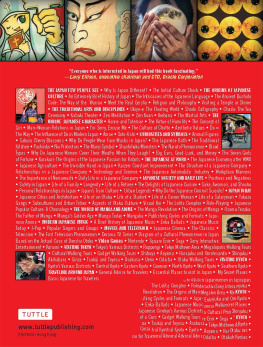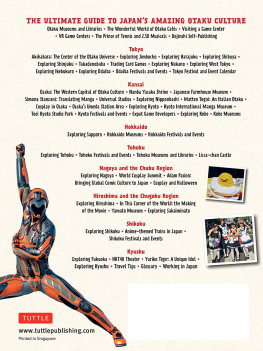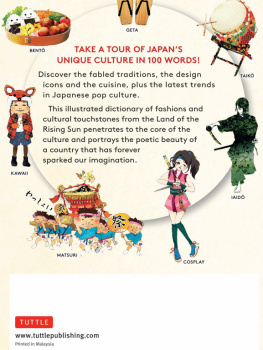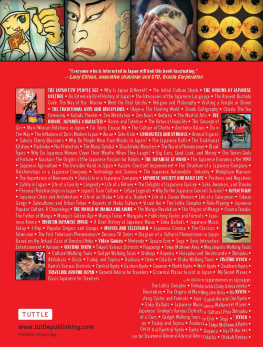
QUICK TAKES
ON CULTURE, ART, HISTORY, FOOD
... AND MORE

Published by
Stone Bridge Press
P. O. Box 8208, Berkeley, CA 94707
TEL 510-524-8732
Text 2021 David Watts Barton.
Illustrations by Yuko Nagasaki.
Front-cover design and artwork by Iku Oyamada, HI(NY) Design.
All rights reserved.
No part of this book may be reproduced in any form without permission from the publisher.
Printed in the United States of America.
10 9 8 7 6 5 4 3 2 1 2025 2024 2023 2022 2021
p-ISBN 978-1-61172-063-1
e-ISBN 978-1-61172-945-0
To Iku:
For years of advice, inspiration, and love.
The moon is beautiful.
PREFACE
Everyone understands that Japan is an important country. But it is useful to remember why. For despite its modest size, Japan consistently punches above its weight.
Among countries measured by land mass, Japan is ranked 61st; with 377,930 square kilometers it is barely bigger than Germany or Vietnam and a bit smaller than California. Despite its modest size, the country is roundly impressive. Japans population ranks eleventh in the world (but is projected to drop below 125 million in 2021 after exceeding 128 million in the first two decades of this century). And in terms of economic output, Japan is positively dazzling: Though it has recently been overtaken in second place by Chinawhich has a population more than ten times as largeJapans is the third-largest economy in the world.
But beyond its population and economy, Japan consistently ranks near the top of the charts in measures of quality of life: literacy, education, safety, access to medical care, health. That Japan is a successful nation is well known.
But there is a level beyond all of these on which Japan excels, the level of culture. Japans cultural products are admired around the world, and not just sushi, anime, and karaoke. Rather, Japan is admired for the fullness and uniqueness of its culture: To say something is Japanese is to understand and admire it for its holistic, organic coherence, even if the speaker isnt well versed in the meanings of Kabuki, the ritual of the tea ceremony, or the nuances of ikebana design.
Despite having its share of societal problemsJapan is by no means perfect, and life for the Japanese can be more stressful and less secure than is imagined from the outsideJapanese society is still remarkably cohesive. Its blend of ancient and modern is united by a distinct Japanese sensibility that is clear even to outsiders.
Most people have little difficulty picturing the superficial expressions of that sensibility: graceful, carefully dressed women and men; efficient, well-functioning cities; studious, respectful children; high-quality food, elegantly served; naturalistic, balanced works of art and architecture; and a seamless integration of technology into daily life. None of these impressions are wrong; they are external expressions of a culture that insists on all these things being true.
But these impressions are, of course, incomplete. Despite its many accomplishments, Japan is also a country where women are still effectively second-class citizens, where men sexually objectify girls with the tacit approval of society, and where the suicide rate is at or near the top of the list among the most affluent countries in the world. Social isolation is a growing problem, especially for older people, but also for the young, who literally hide out from modern life in enormous numbers. The cultural drive for conformity, for social responsibility, for ever-greater education in a stagnant economyas well as other pressures inherent in Japans cultural and economic greatnesscan carry a heavy price. The deeper one dives under the surface of modern Japan, the more obvious these costs become.
Most of these darker aspects are hidden, and visitors wont find their attention drawn to them. Likewise, this book wont dive too deeply into the contemporary sociology of Japan, which is a book or two of its own. Japan is a big, modern country with a long, complex history. In Japan from Anime to Zen, we will deal with the basics.
What we aim to show is that Japanese culture is very much of a piece, that everything is connected to everything else in ways that only slowly reveal themselves: Concepts of symmetry and simplicity, the deep love of nature (and the manipulation of it), the power of space (and the unspoken), the admiration of the imperfect and the aging, and the striving for perfectionthese are among the subtleties that animate and unify Japanese culture into something distinctive.
This book began as a series of blog posts for a website called japanology.org, and many of these essays first appeared there. This book expands upon those posts with additional research, new material, and new essays, all aimed at presenting a unified whole. The text is organized into five subject areas: Food and Drink; Modern Arts, Entertainment, and Sports; Traditional Arts and Culture; History and Archetypes; and The Foundations of Japanese Culture. Each section contains more than a dozen short chapters addressing different topics.
Japan from Anime to Zen can be dipped into at any point, particularly as you encounter a topic during a visit; there is no need to start at the beginning and finish at the end. But contrary to what the title suggests, Japan from Anime to Zen is not a dictionary or an encyclopedia; nor is it in any way comprehensive. The subject of Japan is huge, and this book doesnt aim to cover everythingthat is impossible. But it does offer some insights into aspects of Japanese food, sports, history, arts, architecture, social norms, and religion that the visitor is likely to encounter or perhaps overlook. The idea is to help you be a bit more informed than you might otherwise be.
This book aims to be an informative companion to travel guidebooks with a where/what/when/howand how much?focus. It offers a look at the myriad elements of Japanese culture that you will encounter. For instance: What is that stone pillar you see in Japanese gardens, looking a little like a totem pole of rough shapes piled one atop the other ()?
There are practical answers too: How does one behave in an onsen, at the dinner table, or in a temple or a shrine and whats the difference between the last two ()?
Getting to know Japanese culture is a lifelong endeavor, and no one expects a short-time visitor to become anything approaching an expert. For all its extravagant politeness, which many read as friendliness, perhaps even openness, Japan is that oldest of Western clichs about Asia: It is mysterious. To a substantial degree that is by design. Most Japanese, and certainly the state itself, feel strongly that Japan is for the Japanese. The culture is designed on many concepts you will read about here, including the distinction between in-groups (uchi) and out-groups (soto)and you are very much soto. It is a culture in which there are specific names for the face you show the world (tatemae) and your true face (honne). It is a countryless touristed than othersthat is designed to be seen and appreciated, but not necessarily understood.
And yet, with this books concise glimpses into aspects of this complex, intimidating, and profoundly beautiful country, you may find that you understand it just a little bit bettercertainly quite a bit better than if youd just walked and gawked around Tokyo, Kyoto, or Osaka. You may also see things in Japan that you might not have noticed had you not read about them here. After all, part of Japan being mysterious is that much of its culture is unseen and unspoken.
Next page














